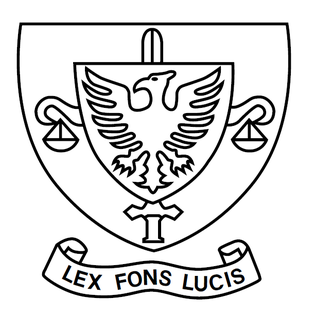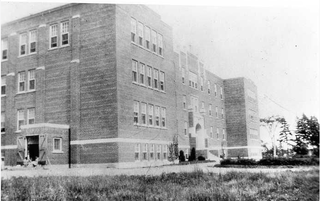
Cape Breton University (CBU), formerly known as the "University College of Cape Breton" (UCCB), is a university in the Cape Breton Regional Municipality, Nova Scotia, Canada. Located near Sydney, CBU is the only post-secondary degree-granting institution on Cape Breton Island. The university is enabled by the Cape Breton University Act passed by the Nova Scotia House of Assembly. Prior to this, CBU was enabled by the University College of Cape Breton Act (amended). The University College of Cape Breton's Coat of Arms were registered with the Canadian Heraldic Authority on May 27, 1995.

Education in Canada is for the most part provided publicly, funded and overseen by federal, provincial, and local governments. Education is within provincial jurisdiction and the curriculum is overseen by the province. Education in Canada is generally divided into primary education, followed by secondary education and post-secondary. Within the provinces under the ministry of education, there are district school boards administering the educational programs.
The Constitution Act, 1982 is a part of the Constitution of Canada. The Act was introduced as part of Canada's process of patriating the constitution, introducing several amendments to the British North America Act, 1867, including re-naming it the Constitution Act, 1867.. In addition to patriating the Constitution, the Constitution Act, 1982 enacted the Canadian Charter of Rights and Freedoms; guaranteed rights of the Aboriginal peoples of Canada; provided for future constitutional conferences; and set out the procedures for amending the Constitution in the future.

The Miꞌkmaq or Miꞌgmaq are a First Nations people indigenous to Canada's Atlantic Provinces and the Gaspé Peninsula of Quebec as well as the northeastern region of Maine. They call their national territory Miꞌkmaꞌki. The nation has a population of about 170,000, of whom nearly 11,000 speak Miꞌkmaq, an Eastern Algonquian language. Once written in Miꞌkmaq hieroglyphic writing, it is now written using most letters of the Latin alphabet.
The Constitutional debate of Canada is an ongoing debate covering various political issues regarding the fundamental law of the country. The debate can be traced back to the Royal Proclamation, issued on October 7, 1763, following the signing of the Treaty of Paris (1763) wherein France ceded most of New France to Great Britain in favour of keeping Guadeloupe.

The Schulich School of Law is the law school of Dalhousie University in Halifax, Nova Scotia, Canada. Founded in 1883 as Dalhousie Law School, it is the oldest university-based common law school in Canada. It adopted its current name in October 2009 after receiving a $20-million endowment from Canadian businessman and philanthropist Seymour Schulich.
The Miꞌkmaq language is an Eastern Algonquian language spoken by nearly 11,000 Miꞌkmaq in Canada and the United States out of a total ethnic Miꞌkmaq population of roughly 20,000. The word Miꞌkmaq is a plural word meaning 'my friends' ; the adjectival form is Miꞌkmaw. The native name of the language is Lnuismk, Miꞌkmawiꞌsimk or Miꞌkmwei.

Métis in Alberta are Métis people, descendants of mixed First Nations/native Indian and white/European families, who live in the Canadian province of Alberta. The Métis are considered an aboriginal group under Canada's Constitution Act 1982 and make up a separate and distinct from the First Nations, and have different legal rights. In Alberta, unlike in the rest of Canada, Métis people have negotiated certain lands to be reserved for them, known today as the Eight Metis Settlements. These Metis Settlements Federated in 1975 to protect existing Metis Settlement lands following the Alberta Governments dissolution, by Order-In-Council of four Metis Settlements from 1950-1960. Following legal challenges by the Federation of Metis Settlements in 1975 for the lose of natural resource against Alberta, the Crown in Right of Alberta settled out of court for a suite of legislation that would see self-government, land, and money transferred to the newly formed government of the Metis Settlements General Council (MSGC), Canada’s only Metis self-govenernment. The Metis Settlements General Council is the legislator of the Federation of Metis Settlements. MSGC is the second largest land owner in the Province of Alberta.
The Kelowna Accord is a series of agreements between the Government of Canada, First Ministers of the Provinces, Territorial Leaders, and the leaders of five national Aboriginal organizations in Canada. The Accord sought to improve the education, employment, and living conditions for Aboriginal peoples through governmental funding and other programs. The Accord was endorsed by Prime Minister Paul Martin, but was never endorsed by his successor, Stephen Harper.

Nova Scotia is a Canadian province located in Canada's Maritimes. In known history, the oldest known residents of the province are the Mi'kmaq people. During the first 150 years of European settlement, the region was claimed by France and a colony formed, primarily made up of Catholic Acadians and Mi'kmaq. This time period involved six wars in which the Mi'kmaq along with the French and some Acadians resisted the British invasion of the region. During Father Le Loutre's War, the capital was moved from Annapolis Royal, Nova Scotia to the newly established Halifax, Nova Scotia (1749). The warfare ended with the Burying the Hatchet Ceremony (1761). After the colonial wars, New England Planters and Foreign Protestants immigrated to Nova Scotia. After the American Revolution, Loyalists immigrated to the colony. During the nineteenth century, Nova Scotia became self-governing in 1848 and joined the Canadian Confederation in 1867.

Higher education in Nova Scotia refers to education provided by higher education institutions. In Canada, education is the responsibility of the provinces and there is no Canadian federal ministry governing education. Nova Scotia has a population of less than one million people, but is home to ten public universities and the Nova Scotia Community College, which offers programs at 13 locations.
The Nova Scotia Human Rights Commission was established in Nova Scotia, Canada in 1967 to administer the Nova Scotia Human Rights Act. The Nova Scotia Human Rights Commission is the first commission in Canada to engage a restorative dispute resolution process.
Nova Scotia Agricultural College (NSAC) was a publicly owned Canadian university college located at Bible Hill, Nova Scotia. The Nova Scotia Agricultural College merged with Dalhousie University and became Dalhousie's Faculty of Agriculture on 1 September 2012. The popular nickname remains the "AC".

Miꞌkmaq militias were made up of Miꞌkmaq warriors (smáknisk) who worked independently as well as in coordination with the Wabanaki Confederacy, French and Acadian forces throughout the colonial period to defend their homeland Miꞌkmaꞌki against the English. The Miꞌkmaq militias deployed effective resistance for over 75 years before the Halifax Treaties were signed (1760–61). In the nineteenth century, the Miꞌkmaq "boasted" that, in their contest with the British, the Miꞌkmaq "killed more men than they lost". In 1753, Charles Morris stated that the Miꞌkmaq have the advantage of "no settlement or place of abode, but wandering from place to place in unknown and, therefore, inaccessible woods, is so great that it has hitherto rendered all attempts to surprise them ineffectual". Leadership on both sides of the conflict employed standard colonial warfare, which included scalping non-combatants. After some engagements against the British during the American Revolution, the militias were dormant throughout the nineteenth century, while the Miꞌkmaq people used diplomatic efforts to have the local authorities honour the treaties. After confederation, Miꞌkmaq warriors eventually joined Canada's war efforts in World War I and World War II. The most well-known colonial leaders of these militias were Chief (Sakamaw) Jean-Baptiste Cope and Chief Étienne Bâtard.
The Qalipu Mi’kmaq First Nation, is a band as defined by the Indian Act, created by order-in-council in 2011 pursuant to the Agreement for the Recognition of the Qalipu Mi’kmaq Band. It represents the Qalipu Mi'kmaq of Newfoundland and Labrador. The band does not control any reserve lands.

The Shubenacadie Indian Residential School was part of the Canadian Indian residential school system and was located in Shubenacadie, Nova Scotia. It was the only one in Atlantic Canada and children from across the region were placed in the institution. The schools were funded through Indian Affairs and the Catholic Church. The institution was like an orphanage, which were the forerunners of contemporary child protection and welfare services. The first children arrived on February 5, 1930 and the institution was closed after 37 years on June 22, 1967. Approximately 10% of Mi'kmaq children lived at the institution. Over 1000 children are estimated to have been placed in the institution over 37 years.
The Native Council of Nova Scotia represents about 25,000 Mi’kmaq/Aboriginal peoples who are non-status or live off-reserve in Nova Scotia and issues its own identity cards. It works to improve their social, economic and political situation. Its head office is in Truro, and it has offices in Sydney, Nova Scotia, Liverpool, Dartmouth, Digby and Coldbrook.
Mi'kmaw Kina'matnewey is an organization that advocates for the educational interests of twelve Mi'kmaw communities in Nova Scotia. It is a corporation without share capital established for the purpose of supporting the delivery of educational programs and services by the Mi’kmaq Education Act of 1998 of the Government of Canada.
Benjamin Kji Saqamaw Sylliboy was a Grand Chiefs of the Miꞌkmaq who lived at the We’koqma’q first nation in Cape Breton, Nova Scotia, Canada. He served as Grand Chief for 25 years from 1992 until his death in 2017.











